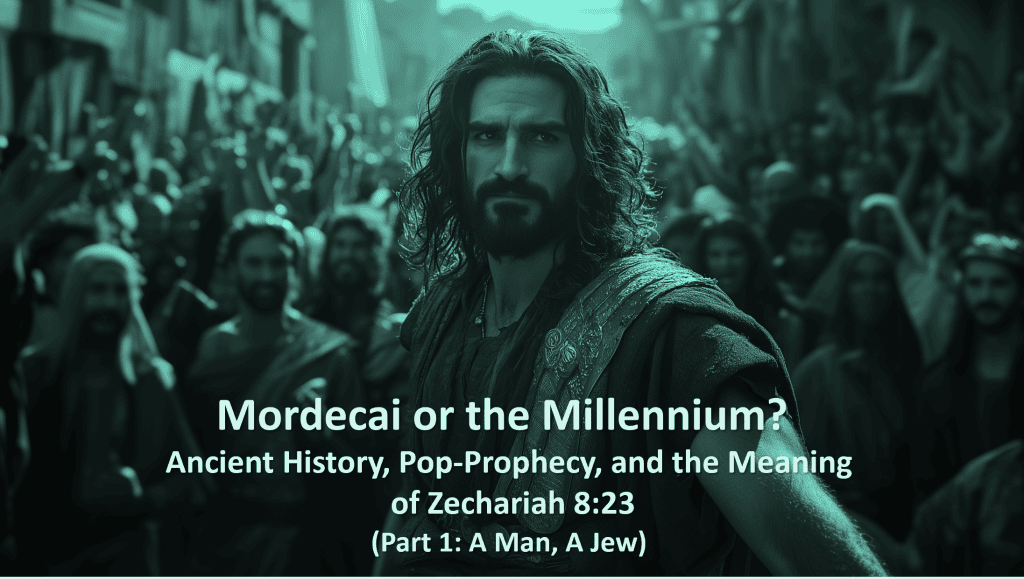Mordecai or the Millennium?
Ancient History, Pop-Prophecy, and the Meaning of Zechariah 8:23
(Part 1: A Man, A Jew)
Copyright © Robert E. Cruickshank, Jr. (August 8, 2024)
All Rights Reserved
Eric Ogea (Editor)
“The Lord of armies says this: ‘In those days ten people from all the nations will grasp the garment of a Jew, saying, ‘Let us go with you, for we have heard that God is with you’” (Zechariah 8:23).
For the purveyors of pop-prophecy, Zechariah 8:23 refers to Jewish superiority during “the Millennial Reign of Christ” after “the Church has been raptured.”[1] Claiming that this passage is “ignored” by the Church and insinuating that those who disagree with him are somehow “antisemitic,” Andy Woods serves as a good example of the pop-prophecy approach:
“Why is a passage like Zechariah 8:23 ignored? Because of the influence of replacement theology, where we as Gentiles think that we got it right and the Jews got it wrong, so, why should they be elevated over us? And it feeds into sort of an antisemitic spirit; and so… So Zechariah 8:23 is never mentioned in church…yet that’s what God says. Israel, you have to understand this, is on a fast track, Deuteronomy, 28, verse 13 where she will be the head and not the tail. She will be above and not underneath. Now, we as the church, clearly are ruling and reigning alongside Christ’s delegated authority as well, Revelation, 5, verse 10, but that doesn’t negate the fact that in the millennial kingdom, God is keeping all of His promises to Israel and He’s elevating them over the nations of the earth. He’s elevating them over the Gentile survivors of the tribulation period that repopulated the earth, and that’s Israel’s future.”[2]
Apparently, today’s prophecy pundits never got Peter’s memo that “God is not one to show partiality” (Acts 10:34). Worse yet, they’ve completely misunderstood, misinterpreted and misapplied Zechariah’s memo. Zechariah mentions nothing about the Millennium, nor does he mention one ethnic group being “elevated” over another. Woods claims that Zechariah 8:23 is ignored, but it’s his approach that ignores the context and setting of the passage.
Zechariah’s 8th chapter finds its fulfillment in the events of the Restoration Period, after the return from exile, and draws striking parallels to Esther’s 8th chapter. In Zechariah 8:23, a specific man, Mordecai, is elevated among his people and no one people group is elevated above another. There is no need to catapult Zechariah’s prophecy thousands of years into the future and/or insert it into a future “thousand years,” i.e., the prophecy pundits’ version of the Millennium in Revelation 20.
Audience Relevance and Historical Context
Zechariah is writing around 520 BC – sixteen years after Cyrus called the Jewish people back to their homeland in 536 BC and four years before the temple was rebuilt in 516 BC.[3] Other significant events on the horizon include Ezra leading a second wave of exiles back to Jerusalem in 458 BC, and Nehemiah rebuilding the city wall in that same year. This is the historical context and setting of the time when Zechariah wrote. The prophet is speaking to the concerns of his own day, not a thousand-year period that concerns people thousands of years away.
Zechariah 8 and Nehemiah 6
A concrete case-in-point example, firmly anchoring Zechariah 8 to the prophet’s own time, would be verses 13-17. These verses have nothing to do with a future Millennium, after a seven-year Tribulation, and everything to do with the events of the Restoration. Specifically, these verses contain a warning not to conspire with those who would lead the resistance movement against Nehemiah’s restoration efforts:
“…Fear (yare) not, but let your hands (yad) be strong (chazaq). For thus says the Lord of hosts: ‘As I purposed to bring disaster to you when your fathers provoked me to wrath, and I did not relent, says the Lord of hosts, so again have I purposed in these days to bring good to Jerusalem and to the house of Judah; fear not. These are the things that you shall do: Speak the truth to one another; render in your gates judgments ac that are true and make for peace; Also let none of you devise (chashav) evil (raah) in your heart against another, and do not love a false oath (shevuah) for all these things are what I hate,’ declares the Lord” (Zech. 8:13-17).
From the overall thematic elements in general, right down to the precise terms and phrases in particular, Zechariah’s words here are an exact match to the events of Nehemiah 6. Zechariah anticipates the conspiracy to take Nehemiah down and Nehemiah’s resolve to stand his ground.
Nehemiah 2 lays the groundwork for the conspiracy that would ensue. In that chapter, we are introduced to “Sanballat the Horonite and Tobiah the Ammonite” who are very displeased to hear that “that someone had come to seek the welfare of the sons of Israel” (Neh. 2:10). In chapter 6, Sanballat and his cohort Geshem wish to meet with Nehemiah under false pretenses (Neh. 6:2a). Nehemiah declines and informs the reader, “But they intended (chashav) to do me harm” (raah). Notice the correlation with Zechariah 8:17 – “let none of you devise (chashav) evil (raah) in your heart against another.”
Sanballat, Geshem, and Tobiah then craft a letter accusing Nehemiah of planning more than simply building a wall (Neh. 6:5-8) – a copy of which would be sent to the Persian king (Neh. 6:6). The accusation is that Nehemiah was plotting a rebellion in which he would take the reigns as the new king of Judah (Neh. 6:6,7). Nehemiah flatly denies the charges, which are nothing more than inventions of their own minds (Neh. 6:8). The express purpose of the false accusation was to induce fear and halt the restoration effort:
“For they all wanted to frighten (yare) us, thinking, ‘Their hands (yad) will drop from the work, and it will not be done.’ But now, O God, strengthen (chazaq) my hands (yad)” (Neh. 6:10).
Again, the parallels with Zechariah are unmistakable: “…Fear (yare) not, but let your hands (yad) be strong (chazaq)” (Zech. 8:13). After admonishing his readers to show courage in the face of fear, Zechariah then charges them to “not love a false oath (shevuah)” – something which the Lord hates (Zech. 8:13).
Accordingly, in Nehemiah 6 “many in Judah were bound by an oath (shevuah)” to Tobiah (Neh. 6:18) who had sent the letter to “frighten (yare)” Nehemiah and discourage the restoration efforts (Neh. 6:19). Zechariah is prophesying to tell the people not to honor that oath nor stand in the way of the work which the Lord would do through his servant, Nehemiah.
The historical situation that Zechariah foresees in 8:13-17 has everything to do with the issues and concerns of his own time and nothing to do with prophecy pundits’ version of the Millennium in a yet future time. As such, Zechariah focuses on Nehemiah – a hero of that time. Even closer in time, another hero would emerge. Like Nehemiah, he would also stand his ground. Literally.
The Events of Esther’s Day – Just a Decade Away
Everyone is familiar enough with the story in Esther. Mordecai, a descendant of King Saul, refuses to bow down to Haman, a descendant of Agag. The conflict between Saul and Agag is rebooted in the book of Esther,[4] and Mordecai overcomes a half a century of shame and restores his family’s name.
When Zechariah penned his prophecy, the epic battle that resulted in 510 BC[5] was just 10 short years down the road. If Haman and his forces had prevailed, all the restoration efforts would have failed. Simply put, there would be nothing to restore and no one left to restore it.
As an Agagite, Haman was part of the Royal bloodline of the Amalekites – Israel’s most ancient enemy. His goal was to wipe the Jewish people out, all of them, in a single day (Esth. 3:23). As history would have it, a young orphan who became queen and her older cousin turned the tables on Haman – and turned history around.
The victory achieved by Esther and Mordecai would see the end of the Amalekites and the inauguration of a new Jewish holiday to commemorate their accomplishment – the Feast of Purim (Esth. 9:26-29). As Anne Wetter writes, Esther and Mordecai prove “to be the worthiest bearers of the Jewish tradition: they have not forgotten to blot out Amalek (Deut. 25,19), and, unlike their forefathers, they have actually managed to perform the deed.”[6]
Mordecai: A Man, A Jew
Taken as a young boy into captivity, Mordecai had spent most of his life in Babylonian exile (Esth. 2:6). While Mordecai’s lineage (Esth. 2:5-6) plays a significant role in the Esther storyline,[7] his introduction into the story begins in a seemingly insignificant fashion. In the opening sentence of Esther 2:5, he is simply “a man, a Jew” (ish Yehudi). This seemingly minor detail, however, becomes a major key in understanding Zechariah 8:23 and speaks to Mordecai’s importance in Jewish history.
While the word “man” (ish) is used 1850 times in the Old Testament, and the word “Jew” (Yehudi) is used 69 times, the two words are coupled together in just two places – Esther 2:5 and Zechariah 8:23.[8] Rendered literally, Zechariah 8:23 says that the people from the other nations “will grab the garment of a man, a Jew” (ish Yehudi).[9] As Christopher Kou says, this “exact emphatic form occurs only” in these two passages.[10] Interpreting Scripture is about connecting dots, and the Biblical writers give us two dots to connect between Zechariah’s prophecy and Mordecai’s legacy.[11]
In part 2, we will continue to connect these dots and explore the unmistakable parallels between Zechariah 8 and the Esther storyline – as the text continues to disconnect with the pop-prophecy storyline.
___________________________________________________________________
[1] https://hermeneutics.stackexchange.com/questions/21584/who-or-what-is-meant-by-the-ten-men-of-zechariah-823
[2] https://www.spiritandtruth.org/teaching/Zechariah_by_Andy_Woods/018_Zechariah_8_16-23/20220216_018_Zechariah_8_16-23_transcript.htm?x=x
[3] Based on William Cox, Biblical Studies in Final Things (Phillipsburg, NJ: Presbyterian and Reformed Publishing Co., 1966, pp. 61-62.
[4] See: Robert E. Cruickshank, Jr., “Gog and Magog, Part 1: From Saul and Agag to Mordecai and Haman” https://burrosofberea.com/gog-and-magog-part-1-from-saul-and-agag-to-mordecai-and-haman/
[5] For the date of the Battle in Esther, see: Phillip Kayer, “Esther” https://biblicalblueprints.com/Sermons/BibleSurvey/14%20Esther?utm_source=kaysercommentary.com ; James B. Jordan, “Esther: Historical & Chronological Comments (I)” https://www.biblicalhorizons.com/biblical-chronology/8_03/ ; Robert E. Cruickshank, Jr., “Dispensationalism Strikes Out Again: Three More Verses They Get Wrong” https://burrosofberea.com/dispensationalism-strikes-out-again-three-more-verses-they-get-wrong/
[6] Wetter, Anne-Mareike. “How Jewish is Esther? Or: How is Esther Jewish? Tracing Ethnic and Religious Identity in a Diaspora Narrative.” (2011): 602.
[7] For the significance of Mordecai’s genealogy in terms of the overall story in Esther, see: Robert E. Cruikshank, Jr., “Gog and Magog (Part 1): From Saul and Agag to Mordecai and Haman” https://burrosofberea.com/gog-and-magog-part-1-from-saul-and-agag-to-mordecai-and-haman/
[8] Jeremiah 34:9 does use the plural, “men of Judea,” but the singular form is paired with the word “Jew” only in Eather and Zechariah.
[9] https://biblehub.com/text/zechariah/8-23.htm
[10] Kou, Christopher, “TWO INSURRECTIONS IN THE BOOK OF ESTHER” (2019), p. 11. https://www.academia.edu/42893475/Two_Insurrections_in_the_Book_of_Esther
[11] Many thanks to Jan Logsdon for her help and suggestions on the content of this article. Thanks as well to Brett Prieto for his feedback on the early draft. And I’m forever indebted to Karen Rogers for her creative writing tips!

